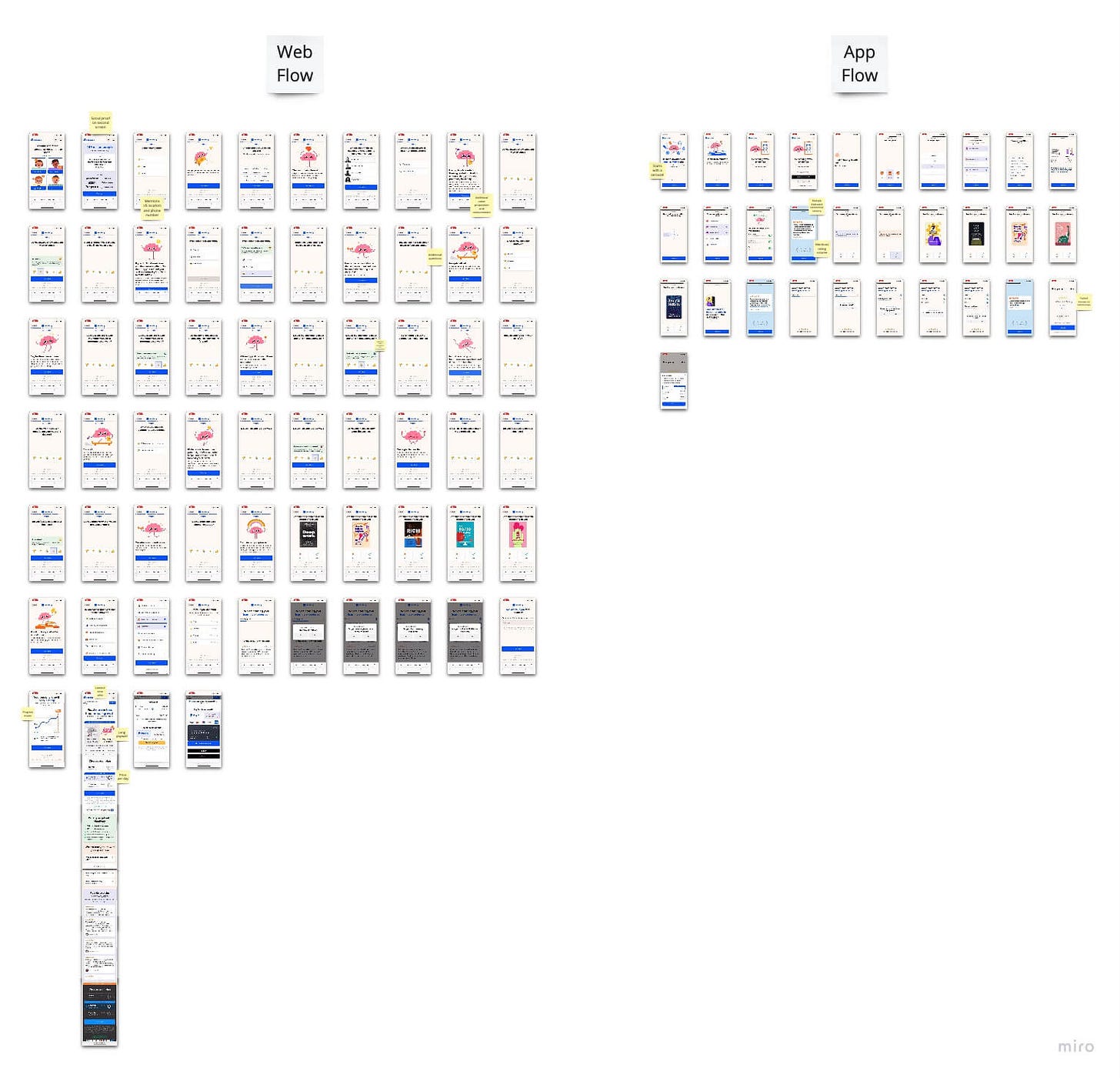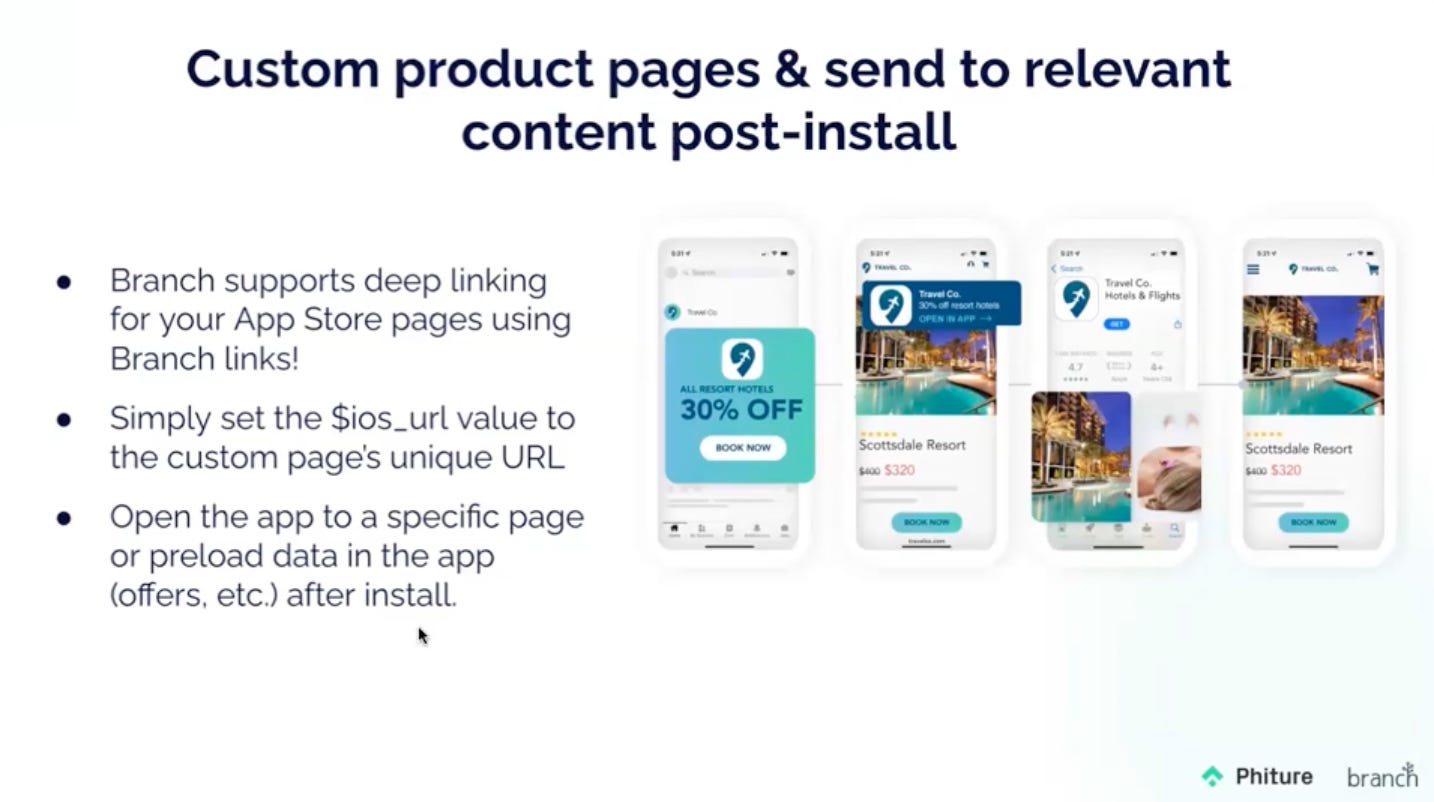💎 Growth Gems #96 - Acquisition & Monetization: Web to app
Hey,
This week I’m sharing gems from Yeva Koldovska on leveraging and optimizing web-to-app.
Enjoy!
🥇 TOP GEM OF THE WEEK
Web-to-app and web purchase flow: unlocks, benefits, and challenges
Driving acquisition traffic to the web has always been around, but only a few mobile-first companies were leveraging this.
Since Apple’s App Tracking Transparency went into effect, we’ve seen more and more adoption of some form of web-to-app.
In the context of acquisition, this typically results in two kinds of “flows” (there are more of course):
Flow #1: Driving traffic to the web to get app installs
Flow #2: Driving traffic to the web to get web trials or purchases (whether there is a web product or not)
Before you send them to a web landing page, the user source itself can vary: potential customers can be from in-app (e.g., Instagram, a game with in-app ads, etc.), or searching/browsing on mobile or desktop web.
Flow #1 above has had a lot of limitations when it comes to measurement and tracking on iOS since SKAN 3.0 did not support web-to-app attribution. This changes with SKAN 4.0 (Safari-only), but if the goal is still to get app installs, it’s still more of a “detour”.
Flow #2 can unlock much more. And that’s what today’s edition is all about!
Yeva Koldovska (Product Manager at Headway) discussed with Olivier Destrebecq on Purchasely’s Subscription League podcast episode Unlocking growth and diversification: the power of web and in-app subscriptions.
Unlocks from web to app
💎 A web flow allows you to diversify and unlock audiences, UA channels, and revenue streams. It is also a way to mitigate the impact of iOS 14.5 and be less reliant on the app stores.
(03:10)
Implementing web to app doesn’t mean you completely stop running app campaigns, and it can be done gradually: you can first test it on specific channel(s) (e.g., Meta and web-specific channels).
You’ll notice that many companies still push users to download their apps from their websites’ homepages. This totally makes sense when the focus is to get users on the app because it makes them more valuable (e.g., an eCommerce brand), but in a lot of cases it’s because they haven’t nailed how to convert on the web.
Many also run both Google web search ads and app install ads via Google UAC (which has Google search placements).
💎 Users who buy on the web and the app are quite different.
Facebook algorithm brings different types of users, as there are different events depending on where users make their purchase (in-app or via the web funnel)
The audience for whom the web product and purchases are easier and more understandable seems to be older
(05:30)
💎 Web purchasers typically have a higher level of commitment to the subscription than on the app: they have higher retention in the product and are easier to re-engage (more likely to open emails), which leads to a higher LTV.
(07:20)
💎 The demographics of app and web users often vary (e.g., web subscribers being older), and web traffic unlocks this additional audience. Age difference also impacts users’ content choices and format preferences (Headway web users like reading vs. consuming audio).
(07:49)
💎 On the web, you are not tied to app releases, so that you can do quicker A/B testing and bug testing. Adding a web flow also increases your A/B testing capacities overall: you can carry tests and learnings from one platform to another.
(13:25)
I wouldn’t carry results automatically from one platform to the other, as you can’t guarantee things will translate.
However, instead of testing brand new hypotheses on each platform, you can A/B test wherever it is faster and only test what worked on the other platforms (plus any platform-specific hypotheses).
Specificities of the web flow
💎 The web funnel tends to be longer and more sales-oriented because more persuasion is needed. A main reason is that on the web, users need to input their card details which is a higher commitment (and typically leads to lower conversion rates).
(06:30)
It’s not fair to compare the conversion rate on the web (e.g., ‘visit → purchase’) to the one in the app (‘install → subscription’) because the app store listing does a lot of the “filtering”. Product page views do not account for search results impressions, so ‘impressions → subscription’ might be a better comparison (although not perfect).
Back to the web flow and how it differs from the app flow…
Yeva shared that the questions asked might differ, and because of the longer funnel, you can better connect with customers and build multiple customized flows.
How much longer is the web flow in Headway’s case, you ask? See below.
This is not just a specificity of Headway, so check out some other apps’ funnels.
Now, let’s play the “10 differences” game 🔍
I don’t have room for that many visuals, but you can see what I spotted here.
💎 Non-trial payment plans perform pretty well on the web. The effort of inputting card details is present regardless of whether it is a free trial or not, so you get similar drop-off rates for trial and non-trial. Web people generally pay more.
(11:30)
💎 Since getting more info is easier due to a longer onboarding, you can personalize the offer based on the information collected. When users feel you have heard and understood them, they are more confident that the product suits them.
(20:55)
💎 On the web, use limited-time offers to create a sense of urgency, and make sure you respect the “logic” of the limited offer (it needs to be real). Example: discount countdown timer to trigger loss aversion, fear of missing out, and urgency biases.
(21:40)
Yeva shared that some users are not ready to buy the product at full price and that offering a trial won’t change that.
That’s why limited offers to the yearly plan (without a trial) work well in the app.
On the web, she recommends discounting the first period (e.g., first month, first quarter, first year) to increase your conversion rates (it will lower LTV, so consider the tradeoff and test your way into it).
💎 Include a variety of payment options on your web checkout so that users can choose the most convenient method. The diversity of payment options also increases trust in your website (e.g., showing Paypal).
(22:20)
The challenges ⚠️
Don’t get started on a web-to-app initiative just yet…
💎 To build a web purchase flow, significant additional resources are needed:
Web design and engineering require different skills
Payment management is more complex (e.g., chargeback)
Tax management can get complicated (country to country, state by state)
Legal requirements might be different
(16:20)
💎 Selling on the web is always more challenging than in the app. The app stores have “standardized” several things to create trust:
Real user reviews
Same structure for all app store pages
People don’t have to input their card data to subscribe
Cancellation process is easy and clear
You don’t have these trust signals on the web, as all websites look different to users. So you need to leverage Conversion Rate Optimization even more.
(17:50)
Based on insights from Yeva and multiple other sources (including what was shared in Growth Gems #81), I compiled the web-to-app benefits and challenges below.

🎁 Bonus Gems
Some more insights you might find helpful on the web-to-app topic!
💎 You can also have different goals for web and app acquisition. For example, on the web, you can focus on the top of the funnel for web education and discovery of your product. Your goal can be getting registrations, then let the CRM team do the rest.
Josh Nadler (Product Manager II, Ads & Attribution at DraftKings) in Bridging the gap between web to app acquisition (16:08)
Josh also mentioned that Meta is rolling out cross-channel conversion optimization, which allows you to optimize for conversions from both your website and app in a single campaign.
Conversions API (e.g., from Meta and Snapchat) is another option to connect an advertiser’s server and an ad network’s Conversions API endpoint.
💎 You can streamline the customer journey from mobile web to app (i.e., bring them to the proper location in the app, like a specific product) while helping your attribution thanks to the clipboard functionality. If they click to download the app and consent to the use of the clipboard, a value is stored and later checked for when the app is first opened.
Victor Savath (VP of Solutions Consulting at Singular) in Bridging the gap between web to app acquisition (1:00:00)
This is something Branch does with their iOS NativeLinks:
💎 When you’re sending users to the app, leverage Custom Product Pages (CPPs) to have continuity with what they saw/did on the web, and use deep links to display the relevant content in the app.
Ramazan Tugay Kahraman (ASO specialist at Phiture) in Web to App – Strategies to Propel Mobile Growth (39:55)
💎 If your goal is to get app downloads, but you want to run web campaigns, you can use Instant Pages (e.g., Meta or TikTok).
George Natsvlishvili (Product Marketing at Air Apps) in Diversifying user acquisition: The Web2App campaign (05:52)
And before I leave, here is a quote from that Singular webinar on why web-to-app is particularly relevant:
“We’re a multi-screen society. Our marketing campaigns should reflect that” - Kristin Kado (Sr. Marketing Manager, Paid Media at LinkedIn)
See you next time. Stay curious!
⛏️ Sylvain
🔗 Sources:
Unlocking growth and diversification: the power of web and in-app subscriptions on Purchasely’s Subscription League podcast
Bridging the gap between web to app acquisition, Singular webinar
Diversifying user acquisition: The Web2App campaign at App Growth Week by Splitmetrics
Web to App – Strategies to Propel Mobile Growth, Branch x Phiture webinar











